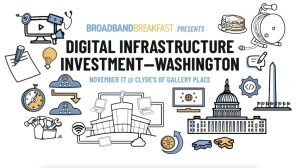
As the new year begins, the Institute for Local Self-Reliance on Thursday, January 18, 2024, announced its latest tally of municipal broadband networks which shows a dramatic surge in the number of communities building publicly-owned, locally controlled high-speed Internet infrastructure over the last three years.
Since January 1, 2021, at least 47 new municipal networks have come online with dozens of other projects still in the planning or pre-construction phase, which includes the possibility of building 40 new municipal networks in California alone.
Ry Marcattilio, Associate Director for Research with ILSR’s Community Broadband Networks Initiative, said the latest wave of new municipal networks runs the gamut from conduit-only networks like the one in West Des Moines, Iowa that brought Google Fiber, Mediacom, Lumen and local ISP Mi-Fiber to town to offer residents a choice of broadband providers.

They also include institutional networks such as the I-net the city of Alexandria, Va. built to serve local government operations, setting the stage for the city to partner with Ting in providing fiber-to-the-home service citywide; to open-access networks like Yellowstone Fiber in Bozeman, Montana; as well as the massive municipal fiber-to-the-home network under construction in Knoxville, Tenn.
The latter network is already offering service to Knoxville residents and businesses, though it will take seven to 10 years before the Knoxville Utilities Board (KUB) finishes building out the entire KUB Fiber network passing all 210,000 households in its 688-square-mile service area. Once completed, KUB Fiber will be one of the largest municipal broadband networks in the nation, rivaling its Chattanooga neighbor EPB Fiber and the multi-state footprint of UTOPIA Fiber.
Inside The Numbers: ‘Enough is Enough’
“From the Midwest to the Deep South, East Coast to West, we’ve seen an incredible amount of new energy by cities over the last two years,” said Marcattilio, Associate Director for Research with ILSR’s Community Broadband Networks Initiative.
- “Dozens of cities, ranging from five thousand and a hundred thousand residents alike, have decided that enough is enough. Instead of pleading with, or giving additional handouts to the monopoly ISPs, they’ve decided to invest in themselves. It’s exciting to see so much happening, especially since we know our numbers are not completely exhaustive as there are no doubt cities building networks that have not yet become active or reported service to the FCC.”
The latest ILSR tally does not include the plethora of other community broadband networks such as member-owned electric cooperatives deploying fiber networks in many hundreds of rural communities across the nation.

It also does not include the rising number of Tribal Nations building and operating their own networks to bridge the digital divide in some of the least connected parts of the country.
ILSR last tallied the number of existing municipal networks in 2021. At that time, there were approximately 400 municipal broadband networks serving some 600 communities, with nearly 1 in 3 serving nearly every address in the community.
The 47 new municipal networks have been added to ILSR’s database, as an increasing number of local communities look to build publicly-owned, locally controlled broadband infrastructure amid a growing public demand for choice and competition among Internet service providers (ISPs).
Christopher Mitchell, who has spearheaded ILSR’s effort to track the birth and development of community broadband across the U.S. for the past 16 years as Director of the Community Broadband Networks Initiative, said:
- “The monopoly cable and telephone companies frequently claim that there are no problems with broadband in the U.S., even as millions of students cannot access the Internet from their homes, whether in rural or urban areas. These cities remind us of the work that has to be done to make sure everyone can take advantage of modern technologies.”
Overcoming Challenges
The growing success of local communities in establishing municipal broadband systems to deliver ubiquitous, affordable, high-quality Internet connectivity hasn’t gone unnoticed by Big Cable and the Telecom Titans who consider municipal broadband an existential threat to their bottom lines.
Dark money campaigns, often funded by the big monopoly incumbents, have been popping up across the country in an effort to persuade local officials and residents to reject municipal broadband proposals, prompting the American Association for Public Broadband to issue alerts to shed light on the misinformation at the center of these campaigns.
Yet, despite efforts to undermine municipal broadband, in the years to come we expect more communities will join the rising tide of local leaders, residents, and businesses calling for an alternative to the private monopoly model in addressing local connectivity needs.
Here are a few snapshots of new municipal broadband networks that have been lit up for service over the last three years:
Sherburne, NY (Sherburne Connect)
One of four municipalities in New York State splitting $10 million from the state’s initial ConnectALL municipal grant program, the Village of Sherburne (est. pop. 1,300) – along with three other municipalities (the towns of Nichols, Diana and Pitcairn) – were awarded the funds to build municipal-owned fiber-to-the-home (FTTH) networks.
In Sherburne, the village’s municipal utility, Sherburne Electric, worked with the New York Power Authority (NYPA) to extend NYPA’s existing middle mile fiber network to bring last-mile fiber service to the village’s 1,800 homes and businesses.
The open access network, known as Sherburne Connect, offers residents two different ISPs from which to choose: Fybercom and FiberSpark. Both offer a symmetrical 100 Megabits per second (Mbps) service for $10/month or symmetrical gig speed service for between $30 and $45/month.
With village residents now getting service, the testimonials are beginning to pour in with one couple saying the network has “brought us to the 21st Century,” giving them “affordable access to high-speed Internet.”
Waterloo, Iowa (Waterloo Fiber)
Construction of the Waterloo Fiber network began last summer with a groundbreaking ceremony hosted by Waterloo Mayor Quentin Hart.
A year ago, the city was putting the finishing touches on a plan to spend $115 million to build a fiber network that passes all 67,695 Waterloo residents, after locals approved the city issuing general obligation bonds to fund the start of the three-phase project.
Waterloo officials recently launched their first limited fiber trial with plans to connect its first commercial customers in February.
The project is on target to deploy affordable fiber service at speeds of up to 10 gigabit per second (Gbps) citywide by 2026.
Competing against the likes of CenturyLink and MediaCom, Waterloo Fiber is offering residential subscribers symmetrical 100 Mbps service for $30/month; 300 Mbps service for $50/month; symmetrical 1 Gbps service for $70 a month; or symmetrical 10 Gbps service for $110 a month. Business subscribers have the option of symmetrical 300 Mbps service for $110 a month, symmetrical 1 Gbps for $250; or symmetrical 10 Gbps for $290 a month.
Central Vermont Communication Union District (CV Fiber)
The Central Vermont CUD, one of the state’s 10 Communication Union Districts established to provide telecommunication service to most towns across the Green Mountain State, connected its first fiber-to-the-home subscriber in October 2023 in the town of Calais. Construction crews have expanded the network into East Montpelier and Worcester, now moving on to Woodbury and Middlesex before expanding into the other 14 towns in CVFiber’s service area.
In late 2022, CVFiber broke ground on an ambitious plan to build a 1,200-mile fiber-optic network to bring affordable gigabit broadband access to 6,000 rural Vermont addresses deemed underserved by commercial broadband providers. Total network construction is expected to cost $60 million, $27 million of which is being paid for by federal grants made possible by the American Rescue Plan Act.
The remaining cost is expected to be funded by network revenue, loans, and future grant opportunities.
CVFiber offers subscribers symmetrical 100 Mbps service for $79 a month; symmetrical 500 Mbps service for $99 a month; symmetrical gigabit service for $129 a month; and symmetrical 2 Gbps service for $199 a month.
Sean Gonsalves is Senior Reporter, Editor and Communications Team Lead, Institute for Local Self Reliance’s Community Broadband Networks Initiative. A version of this piece originally appearing at MuniNetworks.org on January 18, 2024, and is reprinted with permission.
Broadband Breakfast accepts commentary from informed observers of the broadband scene. Please send pieces to commentary@breakfast.media. The views reflected in Expert Opinion pieces do not necessarily reflect the views of Broadband Breakfast and Breakfast Media LLC.



